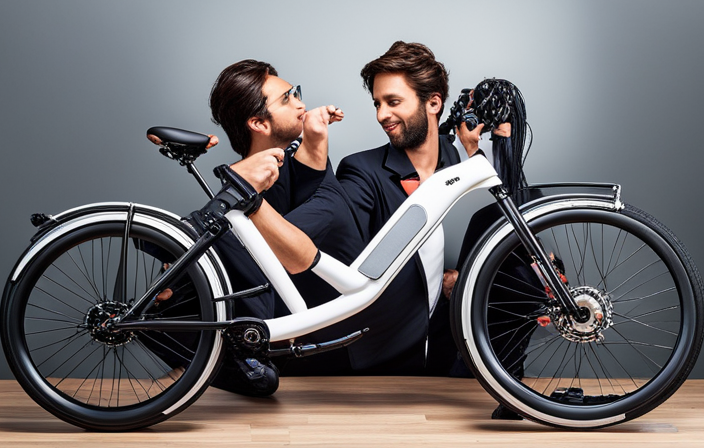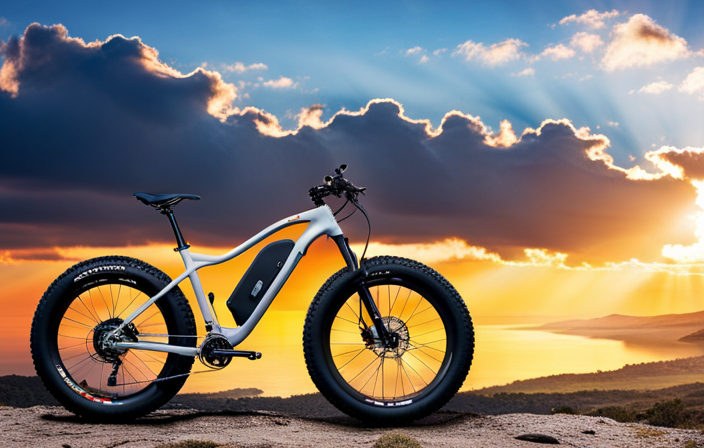What Is Hybrid Electric Bike?
Hey! I’m an expert in hybrid electric bicycles, and I’m here to share with you what really makes these bikes exceptional.
Hybrid electric bikes offer the perfect combination of convenience and power – they’re easy to ride while still giving you an extra boost when needed.
Whether you’re looking for something that can take you from point A to B quickly or just want a leisurely ride around town, hybrid electric bikes are the way to go!
In this article, I’ll explain why these bicycles are such a popular choice among commuters and recreational cyclists.
What Is A Hybrid Electric Bike?
A hybrid electric bike is a modern take on the traditional bicycle. It combines an electric motor with your own pedaling power to create an efficient, fun and convenient ride. This type of bike allows you to tackle various road conditions while enjoying the benefits of both power-assisted cycling and traditional pedal-driven biking.
Whether you’re cruising down city streets or tackling trails, a hybrid electric bike can be the perfect choice for any rider. The most obvious benefit of riding a hybrid electric bike is its ability to cover greater distances than that of a standard bicycle which helps make long trips more enjoyable. Hybrid electric bikes also offer great versatility as they are capable of being ridden in multiple environments like roads, gravel paths, dirt trails and even light snow.

Thanks to their powerful motors and wide range gearing options, riders have the freedom to choose how much effort they want to put into each journey regardless of terrain or weather conditions. At its core, a hybrid electric bike provides riders with improved accessibility when it comes to traveling by bicycle – whether that means getting around town quickly or hitting those tough climbs on your favorite trail.
With so many models available today, it’s easy for cyclists of all levels to find one that suits their individual needs perfectly. As such this type of bike offers true freedom over varying surfaces where other bicycles may struggle making them a popular choice amongst commuters and outdoor enthusiasts alike!
Benefits Of Riding A Hybrid Electric Bike
Riding a hybrid electric bike can be incredibly rewarding, offering both convenience and cost savings. For starters, these bikes are relatively easy to use—you don’t need to know much about mechanics or even cycling itself to get the most out of them. All you have to do is charge the battery, which usually takes only two or three hours, then you’re ready to go.
Compared with other types of bicycles, hybrids offer cost savings in terms of fuel consumption and maintenance costs. They require less frequent oil changes and tire repairs; plus they won’t guzzle gas like traditional motorized vehicles.
Additionally, many governments now provide incentives for people who buy eco-friendly transportation such as hybrid electric bikes.
Hybrid electric bikes are becoming increasingly popular due to their numerous benefits. From ease of use and cost savings, to preserving our environment – there’s no denying that riding one of these machines can make your life easier while also helping keep Mother Nature healthy!
Making the switch from traditional gasoline powered vehicles has never been easier or more affordable than it is today – so why not take advantage?
Types Of Hybrid Electric Bikes
Hybrid electric bikes have become increasingly popular in recent years. In fact, according to a survey by the National Bicycle Dealers Association, sales of hybrid electric bicycles have grown more than 23% annually since 2018. This means that more and more people are recognizing the many commuter benefits associated with these powerful machines!
There are three main types of hybrid electric bikes: pedal-assist models, throttle twist models, and full-throttle speed pedelecs.
Pedal-assist models provide an extra boost when needed for hills or long rides; they use sensors to detect how hard you’re pedaling and give assistance accordingly.
Throttle twist models allow riders to control their own speed through twisting the handlebars; this is great for those who want to go faster but still get some exercise from pedaling.
Full-throttle speed pedelecs are like motorbikes with pedals – they reach higher speeds quickly and require no effort from the rider other than steering.
When it comes to battery life, most modern hybrid electric bikes offer between 30–60 miles per charge depending on terrain and riding style. Some even come equipped with smart technologies that optimize power usage so you can get the most out of each ride!
With such reliable battery performance and versatility, it’s easy to see why hybrid electric bikes have been embraced by commuters everywhere.
Motor And Battery Power
When it comes to electric bikes, motor power is key. Batteries provide the juice, but they can’t do much without the motor.
Battery range is important too – how far can you go on a single charge? Recharging is easy, and efficiency is high.
Speed and torque will be determined by the motor and battery combination, so it’s important to consider cost, weight and maintenance when selecting a system.
Safety, longevity, adaptability, portability, noise and other factors should also be considered.
Motor Power
When it comes to hybrid electric bikes, motor power is a key factor in ensuring an enjoyable ride. I’m here to tell you that these incredible machines are capable of remarkable feats when it comes to performance and efficiency.
The battery life on modern hybrid electric bikes has been greatly improved with the latest advancements in technology, while still being able to produce reliable amounts of torque for impressive acceleration and climbing performances. With their efficient motors, they can provide riders with plenty of hours of riding pleasure without having to worry about draining the batteries too quickly.
Moreover, their motors have also made great strides in terms of energy efficiency; allowing them to reach respectable speeds even at low speed settings which helps conserve battery life.
To sum up, hybrid electric bikes are awesome pieces of engineering that combine both motor and battery power together beautifully so that everyone from beginners to experienced cyclists alike can enjoy the fun and convenience they bring!
Battery Power
When it comes to hybrid electric bikes, battery power is just as important as motor power.
The latest advancements in technology have greatly improved the battery life on these machines so that riders can enjoy hours of riding pleasure without worrying about draining their batteries too quickly.
With reliable amounts of torque and efficient motors, you can accelerate quickly and climb steep hills with ease, making them perfect for all levels of cyclists.
Battery power makes your ride smooth and enjoyable each time -no matter where you go!
Battery Range
When it comes to hybrid electric bikes, battery range is just as important as motor power. A bike’s performance limits are greatly affected by the amount of charge in its batteries and how far you can go without having to recharge them.
Therefore, it’s essential that riders understand what their charging options are and how these affect their overall range. It’s important for cyclists to be aware of how long they need to ride before needing to plug-in and get a full recharge.
The latest advancements in technology have made charging much more efficient and convenient so riders don’t have to worry about running out of juice while on the move! Additionally, many modern bicycles come with removable batteries which make recharging easier than ever – simply pop out your dead battery and replace it with a fully charged one!
Nowadays, there’s no excuse not to enjoy hours of riding pleasure thanks to reliable battery ranges in hybrid electric bikes.
Range And Speed
When it comes to range and speed, hybrid electric bikes are a great choice. The power output from the motor is combined with your own pedal power giving you an effortless ride for miles on end. With most models, you can expect a battery life of between 25-55 miles depending on the terrain and how much assistance you use while cycling. This makes them ideal for commuting trips, weekend rides or even touring holidays!
The level of assist that’s available is also worth considering when purchasing a hybrid bike. Most will offer three levels of assistance – low, medium, and high – allowing you to get up those hills with ease, as well as providing help if there’s a headwind or if you just need some extra energy when going further distances.
Thanks to their design and power source options, hybrid electric bikes provide riders with all the benefits of both traditional bicycles and e-bikes in one package. From excellent range to being able to tackle challenging terrains with ease, these bikes have become increasingly popular over recent years due to their versatility and convenience. They’re perfect for anyone who wants to go farther than they could before without having to worry about running out of battery power or having limited speeds like other conventional modes of transport.
Ready to find out what kind of cost comes along with this type of bicycle? Let’s take a look at how much money we’ll need to shell out next…
Cost Of A Hybrid Electric Bike
Investing in a hybrid electric bike is like taking a leap of faith into the future. It’s not just about getting around, but it’s also about saving time and money for your daily commute. Hybrid electric bikes offer all the benefits of regular bicycles with an added bonus of electrical power to make your ride easier and faster.
When considering such an investment, price comparison and battery life are two essential factors that should be taken into account. Price can vary significantly depending on what type of hybrid electric bike you purchase as well as its features and capabilities. The costlier options often come with more efficient motors and better batteries which will ensure longer rides or greater speed. On the other hand, lower-priced models may require frequent charging due to their less powerful motor or smaller capacity battery. Shopping around for different brands and models should help find exactly what fits within your budget without sacrificing quality or performance.
The other important factor when choosing a hybrid electric bike is the battery life – both how much charge it holds and how long it lasts before needing recharging again. This will depend on several key components such as wattage, amp hours (Ah), voltage, size, weight etc., so being aware of these details can help determine if the overall lifespan meets your specific needs. Additionally, some manufacturers provide warranties to protect against any defects in materials or workmanship ensuring peace of mind while riding out on the open road!
With this information in mind, we can now move onto discussing maintenance requirements for a hybrid electric bike...
Maintenance Of A Hybrid Electric Bike
Now that you know the cost of a hybrid electric bike, it’s important to understand how to maintain one. To make sure your bike is running smoothly and safely, there are certain maintenance tasks you should be aware of.
The first thing to consider when maintaining a hybrid electric bike is battery life. Depending on the type of battery your bike has, lithium ion or nickel-metal hydride, its life can vary greatly. Lithium ion batteries have longer lifespans than their counterparts – up to 1000 cycles compared to 400 for nickel metal hydrides. It’s also important to keep an eye on the charging process; overcharging can reduce your battery’s longevity significantly.
Another issue with any bicycle is brake maintenance. With regular use, brakes tend to wear down quickly so it’s important to check them frequently and replace as necessary.
In addition, ensure that all cables and levers stay in good condition by regularly cleaning them with lube or oil if needed. This will help prevent rust build-up which can lead to further damage down the line.
In order for your ride experience to remain safe and enjoyable, it’s essential that you follow these steps regularly in order to maintain your hybrid electric bike properly. From batteries and brakes, following these simple guidelines will give you peace of mind knowing your bike is in top shape every time you get out on the road!
Safety Considerations
It is estimated that over 300,000 hybrid electric bikes are currently in use worldwide. But with this new technology comes a few extra safety considerations for riders to think about. Here’s what you need to know:
- Make sure your bike has working headlights and taillights for night visibility when commuting or riding in low light conditions.
- Stay visible by wearing bright colors or reflective clothing while riding.
- Learn the local laws regarding helmet use when cycling on public roads.
- Be aware of other drivers and always be prepared to take evasive action if necessary.
- Invest in an anti-theft device such as a U-lock so your bike won’t get stolen while parked at home or work.
By being mindful of these key points, cyclists can make their ride both safe and enjoyable no matter where they choose to go! With the proper preparation, it is possible to enjoy all the benefits of a hybrid electric bike without compromising one’s safety.
Now let’s move onto discussing comfort and control…
Comfort And Control
When it comes to riding a hybrid electric bike, comfort and control are top priorities. With the right setup, cyclists can experience levels of stability and security that only come from having an optimized combination of power assistance and human input.
I’m talking about reliable grip for steering, smooth shifting between gears, responsive brakes when you need them, and plenty of cushioning in the saddle.
All these features work together to provide riders with the assurance they need to tackle any terrain without feeling overwhelmed or out of balance.
Advanced control systems also ensure that your hybrid e-bike is performing at its peak performance level no matter what situation you find yourself in. From simple accelerometer monitoring to more sophisticated algorithms designed to evaluate rider behavior – modern hybrids have it all!
You can rest assured knowing that your ride will be safe, efficient, and enjoyable each time you get on two wheels.
Environmental Impact
It’s no secret that the impact of climate change and air pollution has been a major concern for many experts over the past few years.
As such, it would make sense why so many people are turning to hybrid electric bikes as an eco-friendly transportation alternative to reduce their environmental footprint.
As a hybrid bike expert, I believe this is the perfect time to take advantage of the benefits that come with owning one of these amazing machines.
Not only do they have lower emissions than traditional vehicles, but also provide users with exceptional power capabilities due to its dual-powered system which combines both pedaling assistance and throttle control.
This combination gives riders more maneuverability in any terrain while providing them with all the exercise they need from cycling without having to worry about tiring themselves out too quickly.
It’s truly revolutionary!
Plus, you can still get your daily dose of Vitamin D while reducing your carbon footprint – what could be better?
With all these advantages there is no doubt that hybrid electric bikes are becoming increasingly popular among environmentally conscious individuals who want cleaner transport options.
Pedal Assist Vs. Throttle-Controlled Bikes
As the debate surrounding hybrid electric bikes continues, it’s important to understand how these models differ from their traditional counterparts. Specifically, there are two distinct types of bike: pedal assist and throttle-controlled.
Pedal assist bikes rely on a combination of human power and battery assistance to propel them forward. This type of bike is great for those seeking an efficient ride that isn’t too challenging — they can benefit from increased pedal efficiency while also conserving energy through the use of its battery life.
On the other hand, throttle-controlled bikes tend to be more powerful but require less physical effort than pedal assists. They are ideal for riders who want to cover longer distances with minimal exertion or those who live in hilly areas where pedaling alone wouldn’t be enough.
No matter which type you choose, both will enable you to enjoy a comfortable and enjoyable ride without breaking much sweat! The next thing we’ll look at is weight and portability – factors that make hybrids even more attractive for commuters and recreational cyclists alike.
Weight And Portability
Weight and portability are two key factors that determine the ease of use when it comes to hybrid electric bikes.
Most hybrid electric bikes feature a lightweight frame, allowing you to easily carry it around with you wherever you go. Additionally, many models offer folding capabilities so that they can be stored in tight spaces or brought along on trips without taking up too much room. This makes them ideal for urban commuters who need something light enough to transport but powerful enough to get them where they want quickly.
Storage options also play an important role in how easy a particular bike is to use. Many hybrid electric bikes have removable batteries which make charging and storage easier than ever before. These types of bikes often come with locks for extra security and protection from theft, making them perfect for people who don’t want their investment at risk.
Furthermore, some models even offer integrated carrying systems so that riders can easily take their bike with them on public transportation or other modes of travel.
These features create convenience for anyone looking for an eco-friendly way to get around town without having to sacrifice comfort or safety. It’s no wonder why these types of vehicles are becoming increasingly popular among city dwellers! With the right accessories, your hybrid electric bike will become an indispensable part of your daily life – one that you won’t regret investing in.
Popular Brands Of Hybrid Electric Bikes
As a hybrid electric bike expert, I can tell you that there are plenty of great brands out there to choose from. It really comes down to personal preference and what type of riding you plan on doing.
Some popular brands include Trek, Giant, Specialized, Cannondale, and Rad Power Bikes.
When selecting your bike, it is important to look at the battery life as well as features like suspension or assist modes. If you plan on taking long rides with lots of hills then having an extra boost in power will come in handy. Be sure to check how much range each model offers so you don’t find yourself stranded halfway through your ride.
No matter which brand or type of hybrid electric bike you select, be sure to take into account the accessories available for it too! From racks and baskets for carrying gear to lights and locks for keeping your ride secure – these accessories can make all the difference when heading out on a journey.
With the right selection of gear, you’ll be ready to explore anywhere!
Accessories For Hybrid Electric Bikes
The selection of accessories for hybrid electric bikes is vast and varied. From extra batteries to increase the range of your bike, to customizing its look with new colors and designs, you can personalize your ride in any way that suits you best.
Depending on your riding style and needs, there are a wide variety of options available when it comes to sprucing up or boosting the performance of your bike. Power output is often an important factor when shopping for accessories for hybrid electric bikes. Whether you’re looking for more torque or just want to tune-up the engine, there are plenty of options out there like additional accelerator units or throttle controllers.
Batteries also play a vital role in power delivery; if yours isn’t giving you enough juice, consider investing in an upgraded battery with longer battery life so you can get more mileage out of each charge. Speaking of charging cycles, many riders opt for solar panels as an eco-friendly way to keep their batteries topped off without relying on grid electricity. This can be especially useful if you plan on taking long trips away from civilization where access to outlets may not be readily available.
Solar panels come in various sizes depending on how much energy storage capacity you need and how quickly you want them to recharge. No matter what kind of upgrade or accessory you choose, make sure that it’s compatible with your bike model before making a purchase – safety should always be paramount!
With the right combination of parts and components, you’ll have no trouble getting the most out of your hybrid electric bike while staying safe along the way. Time now to explore where this journey takes us next – finding the perfect place to buy one…
Where To Buy A Hybrid Electric Bike
When it comes to purchasing a hybrid electric bike, there are several important things to consider. Firstly, you should take the time to test ride different models and find one that best suits your needs. This will allow you to get accustomed with how an e-bike feels before you make an investment.
Secondly, look for features such as power assist levels that can be adjusted during rides and ensure that the frame is strong enough for trail riding if this is something you plan on doing.
Here’s what I recommend when shopping for a hybrid electric bike:
- Take multiple test rides so you can compare bikes and make sure they fit comfortably
- Look at the battery life of each model – some offer longer range than others
- Make sure the motor has adjustable power levels so you can adjust them while out on a ride
- Pay attention to the frame material – it’s important that it’s durable enough for off-road use if necessary
Finally, do research online or talk to people who have experience with hybrid electric bikes in order to gain more insight into which type may suit your riding style best. Ultimately, investing in a good quality bike now could save money down the line due to its durability and long-lasting capabilities.
Frequently Asked Questions
How Long Does It Take To Charge A Hybrid Electric Bike Battery?
Charging time for a hybrid electric bike battery varies depending on the type of battery, but typically it takes between 3 to 6 hours.
With proper maintenance and care, these batteries can last up to 1000 charge cycles or even more!
As an expert in this field I recommend that you always use the right charger designed specifically for your hybrid electric bike when charging the battery as using other chargers may affect battery life.
Plus, make sure you keep an eye on the level of power remaining in your battery so you don’t get stranded mid-ride due to lack of charge.
Is It Difficult To Ride A Hybrid Electric Bike?
Riding a hybrid electric bike isn’t difficult at all! In fact, it’s actually quite easy because of the cost benefits and safety features that come with them.
Hybrid electric bikes have been designed to make sure cyclists are comfortable while riding and also enjoy their ride without having to worry about safety concerns.
The combination of an electric motor and human power gives riders more control over their speed and handling.
All in all, you can rest assured that your experience on a hybrid electric bike will be safe, stress-free, and enjoyable!
Is A Hybrid Electric Bike Suitable For All Terrains?
Are you wondering if a hybrid electric bike is suitable for all terrains?
The answer is yes! This type of bike offers cost savings and performance benefits that are perfect for any terrain. Plus, its advanced technology makes it easy to ride and control your speed on the roads, hills or off-road paths.
As a hybrid electric bike expert, I can confidently say that this type of bike will make your outdoor adventures more enjoyable, no matter what terrain you choose.
Are There Any Age Restrictions For Hybrid Electric Bike Riders?
When it comes to riding a hybrid electric bike, there are no age restrictions. Whether you’re young or old, anyone can enjoy the fun and convenience of a hybrid electric bike!
However, depending on your particular needs and riding styles, different maintenance costs may apply. For example, if you plan to take long rides at high speeds often, then having regular tune-ups is important for keeping your bike in tip-top shape.
On the other hand, casual riders will find that basic maintenance is all they need to keep their bikes running smoothly. In any case, with proper care and upkeep, hybrid electric bikes are suitable for riders of any age!
Is It Safe To Use A Hybrid Electric Bike In Bad Weather?
Yes, it is safe to use a hybrid electric bike in bad weather! The motor power and battery life of most hybrids are reliable enough to handle the rain and wind that can come with inclement weather.
However, for added safety measures, I recommend wearing bright colors or reflective gear so drivers can see you better. It’s also important to check your brakes before riding off into wet conditions – make sure they’re working properly and not slippery from water or debris.
With the right precautions taken, using a hybrid electric bike during poor weather should be an enjoyable experience!
Conclusion
In conclusion, hybrid electric bikes are an innovative and convenient way to get around. They offer a great combination of physical exercise with the added bonus of assistance from an electric motor.
As long as you charge your battery regularly, it’s easy to ride these bike in all terrains – even if they seem like they’re straight out of a sci-fi movie! While there is no age restriction for riding one of these nifty machines, always make sure that you check the weather before heading out for a spin.
Hybrid electric bikes are reliable and safe in most conditions, but bad weather can sometimes be too much for them to handle. So make sure you use good judgment when deciding whether or not to take your hybrid electric bike out on a windy day.
















